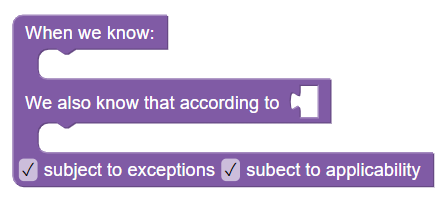Attributed Rule Block

Where Is It?
The attributed rule block is found in the Primary drawer of the Blawx toolbox.
What Does It Do?
The attributed rule block is used to set out rules with which Blawx can infer new information from facts, and attribute that conclusion to a section of the legislation.
The first statement connector, labeled "When we know:", allows you to set out the conditions in which the rule is true.
The second input connector allows you to specify the section of the rule to which the conclusion can be attributed.
The third statement connector allows you to set out the new conclusion that can be drawn when the conditions are known to be true. This should be a single statement.
It also has two checkboxes for "subject to exceptions" and "subject to inapplicability".
If you choose "subject to exceptions", the conclusion in that rule can be defeated by conclusions in other rules, typically set out using the overrules block.
If you choose "subject to inapplicability", the effect of that rule can be turned off with regard to specific objects, typically by using the "applies" block, and wrapping it in the "it is false that" negation block.
Technical Details
The rule block is an outer block.
Its top statement connector accepts a stack of one or more condition statements. These statements are treated as though they are all connected with an "and" operator, and all variable names are shared among them, and with the conclusion.
Its bottom statement connector accepts exactly one conclusion statement.
The attributed rule connector actually uses three different rules to reach a conclusion, which can be summarized like this:
- If the conditions are true, and (if subject to applicability) the section applies, then according to the section the conclusion is tentativley true.
- If according to the section the conclusion is tentatively true, and (if subject to exceptions) no exceptions apply, the conclusion in this section holds.
- If the conclusion in this section holds, that conclusion is true.
See the defaults and exceptions portion of the documentation for more details.
Tips
Blawx does not currently support an "or" operator. In the meantime, if the same conclusion can be reached in multiple ways, that should be represented by multiple rules with the same conclusion.
If multiple rules with the same conclusion, attributed to the same rule exist, all of them will be affected by overrules blocks.
Typically, you will want to avoid having variables in the conclusion that are not also present in the conditions.